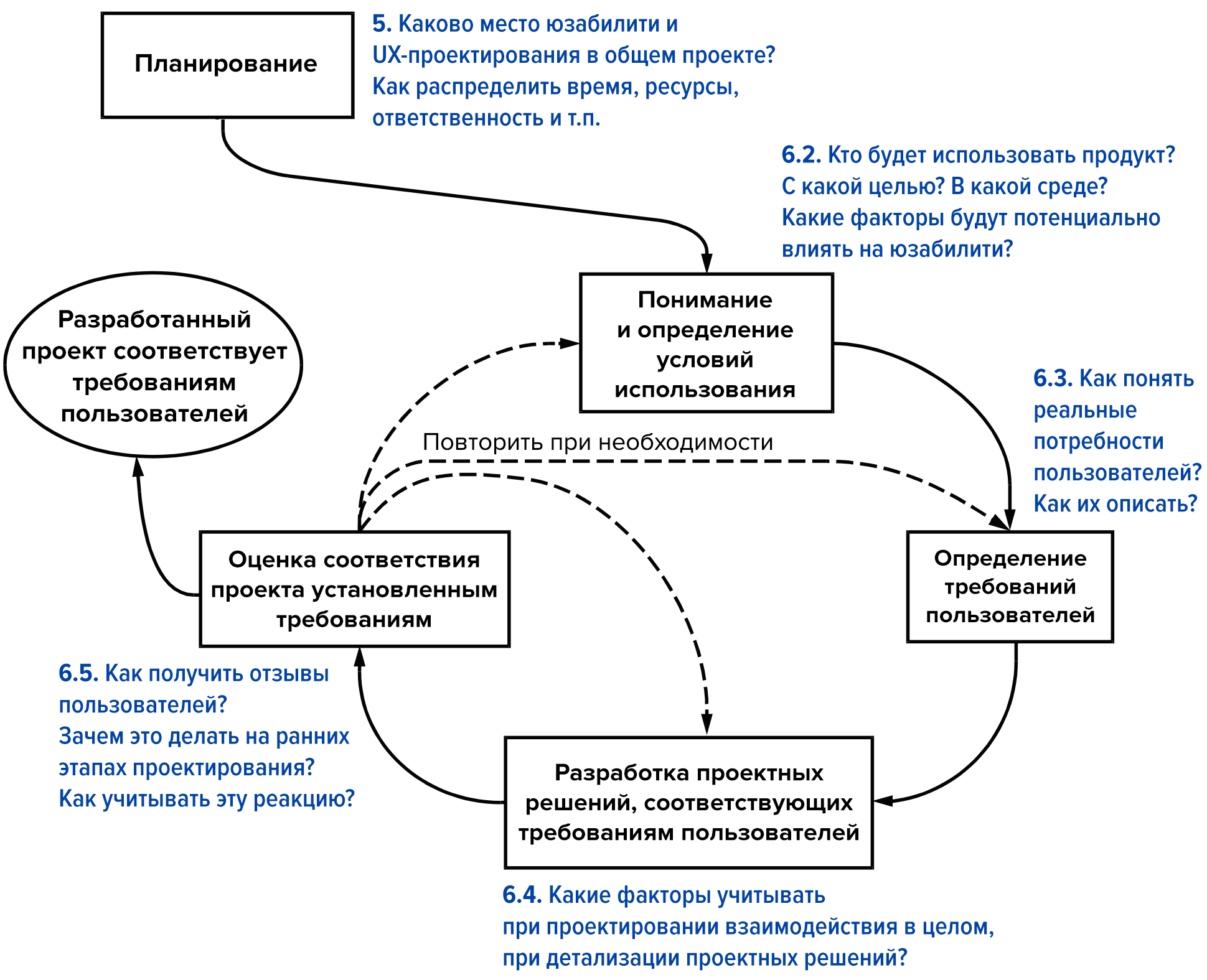GOST usability
In a week, the national usability standard GOST R ISO 9241-210-2012 “Ergonomics of human-system interaction will come into effect throughout Russia . Part 210. Human-oriented design of interactive systems . "
I want to briefly explain why this document is not an empty sound. Let's go in order.
Who needs it?
Russian translation needs some work, but it's a matter of time.
')
GOST - about emotions! A pleasant surprise.

In the third section, on the whole A4 sheet, various advantages and benefits of human-oriented design are described. That increasing usability saves millions of dollars is understandable. But here, down to private work issues:
This standard does not come up with new methodologies, but teaches us how to introduce a human-oriented approach to existing processes. Just a shift in emphasis.
Briefly, the ideas-principles in subsections:
How to interpret this information? The GOST is not written, so I want to stay more. Let's call this mutual destruction of illusions .
The illusion of the designer: "the user's thinking is arranged about the same as mine . "
User’s illusion: “cars do not exist, only horses exist”
The user does not know what can be done more conveniently.
The designer does what is convenient for him. He has a handy set of user stories - from which the obvious decisions follow - which the user has to put up with .
Not.
To make a really cool product, you need to get out of your comfort zone and understand what the user needs , provided that he cannot explain it himself.
Not a designer, not a user - it should be the third person who will destroy their illusions. And this will be a new dimension.
These two sections govern the implementation of the above principles. I do not want to go into much detail (the purpose of this post is to give a brief overview, to interest). The document is well structured, so those who wish will quickly find the necessary information.
There is a scheme, I signed to it, what issues are considered in each paragraph:

In paragraph 6.3 you can find a couple of interesting points:
“It is necessary to determine the needs that should be met (and not the ways in which these needs should be met)”. (6.3.2)
"The specification of user requirements should be made taking into account the possibility of testing at later design stages." (6.3.5)
That is, two things are said directly, see above about two illusions :
6.3.2. The user does not know what he wants. No cars, only horses.
6.3.5. We initially could very seriously make a mistake about what the user needs.
The axiom about the iterative approach is repeated several times ... Probably, in the future, PMs can safely write:
"Based on clauses 4.1 (d), 4.5, 5.3 (f), 5.5 and 6.4.3 (d), we need to allocate time for another iteration." :)
It says that human-centered design (as described in the standard) plays an extremely positive role in the sustainable development of humanity. Here I would argue. The authors of the standard constantly talk about some unconditional, thoughtless maximization of comfort for the consumer.
If all our future is to sit on the couch and chew popcorn - then yes, there is everything for sustainable development. But I think that habrayusers have another idea about the XXII century, to which one of us will live, which means that there is still a very difficult choice: to give a fish or a bait?
Ergonomics? Fi, this is not it! Usability is wider than ergonomics, you say.
Yes, the concept of "usability" includes ergonomics. But wait: how do they define the “human-oriented design” of which standard?
And here's usability! “Suitability” is not a clear phrase, but this is how they translate the word “usability”. Probably, when the universal comesto ... minimalism, then the GOST of usability will be called the "GOST of usability." But so far.
Human-centered design (human-centered design) is a way of developing interactive systems aimed at creating usable and useful systems ...
And here's usability! “Suitability” is not a clear phrase, but this is how they translate the word “usability”. Probably, when the universal comes
I want to briefly explain why this document is not an empty sound. Let's go in order.
1. Tasks of the document
Who needs it?
- Managers - to show the place of the human factor and ergonomics in the design process.
- UX-specialists - to tell how the design takes place, and what is their participation in this process.
2. Definitions
Russian translation needs some work, but it's a matter of time.
Snarling mode
The main thing - the meaning of the document ISO 9241-210: 2010 did not disappear anywhere in the translation. For example, a couple of quotes:Accessibility is usability “for people with the widest range of possibilities.” Go guess that the "wide range" refers to people with disabilities .
')
Systems with high usability have a number of advantages, including better performance, stress prevention, increased availability and reduced risk of harm.(usability = usability)
Suitability, if interpreted in terms of users' personal goals, may include perceptual and emotional aspects, usually associated with user experience. Usefulness criteria can be used to assess aspects of user experience.
GOST - about emotions! A pleasant surprise.

3. Why think about usability
In the third section, on the whole A4 sheet, various advantages and benefits of human-oriented design are described. That increasing usability saves millions of dollars is understandable. But here, down to private work issues:
... has a beneficial effect on other aspects of system design, for example, by simplifying the identification and formulation of functional requirements.
... increases the likelihood of successful completion of the project on time and within budget.:)
4. Principles of human-centered design
This standard does not come up with new methodologies, but teaches us how to introduce a human-oriented approach to existing processes. Just a shift in emphasis.
Briefly, the ideas-principles in subsections:
4.2. User needs
Accurately identify users, tasks, terms of use.4.3. Involving users in development
Not only "to order", but also when creating a universal / consumer products.4.4. Feedback from users
User feedback (including at the design stage) is the most important source of information.How to interpret this information? The GOST is not written, so I want to stay more. Let's call this mutual destruction of illusions .
The illusion of the designer: "the user's thinking is arranged about the same as mine . "
User’s illusion: “cars do not exist, only horses exist”
(fast and slow)
"If I asked my future buyers what they needed, they would ask for faster horses."
Henry Ford , Founder, Ford Motor Company
Henry Ford , Founder, Ford Motor Company
The user does not know what can be done more conveniently.
The designer does what is convenient for him. He has a handy set of user stories - from which the obvious decisions follow - which the user has to put up with .
Not.
To make a really cool product, you need to get out of your comfort zone and understand what the user needs , provided that he cannot explain it himself.
Not a designer, not a user - it should be the third person who will destroy their illusions. And this will be a new dimension.
4.5. Iterative improvement of the project
This, again, is about user participation in design. At the beginning it is impossible to provide every detail. Many needs and expectations of users are revealed only during the design, as developers improve their understanding of users and their tasks, and users describe their wishes in response to the presented design solutions.4.6. Consider user experience
Given the previous user experience, you need to keep in mind many aspects. User’s personal goals, emotions and perceptions, expectations and satisfaction, packaging and brand image, non-monotony and much more.4.7. Other design participants
In addition to UX-specialists and users - who else is involved in the development of UX-design? These are specialists with different points of view on a project, possessing knowledge in different areas. Marketers, technical writers, system analysts, all sorts of managers, and even designers.5-6. Project Planning and Implementation
These two sections govern the implementation of the above principles. I do not want to go into much detail (the purpose of this post is to give a brief overview, to interest). The document is well structured, so those who wish will quickly find the necessary information.
There is a scheme, I signed to it, what issues are considered in each paragraph:

In paragraph 6.3 you can find a couple of interesting points:
“It is necessary to determine the needs that should be met (and not the ways in which these needs should be met)”. (6.3.2)
"The specification of user requirements should be made taking into account the possibility of testing at later design stages." (6.3.5)
That is, two things are said directly, see above about two illusions :
6.3.2. The user does not know what he wants. No cars, only horses.
6.3.5. We initially could very seriously make a mistake about what the user needs.
The axiom about the iterative approach is repeated several times ... Probably, in the future, PMs can safely write:
"Based on clauses 4.1 (d), 4.5, 5.3 (f), 5.5 and 6.4.3 (d), we need to allocate time for another iteration." :)
7. Sustainable development
It says that human-centered design (as described in the standard) plays an extremely positive role in the sustainable development of humanity. Here I would argue. The authors of the standard constantly talk about some unconditional, thoughtless maximization of comfort for the consumer.
If all our future is to sit on the couch and chew popcorn - then yes, there is everything for sustainable development. But I think that habrayusers have another idea about the XXII century, to which one of us will live, which means that there is still a very difficult choice: to give a fish or a bait?
Source: https://habr.com/ru/post/203308/
All Articles